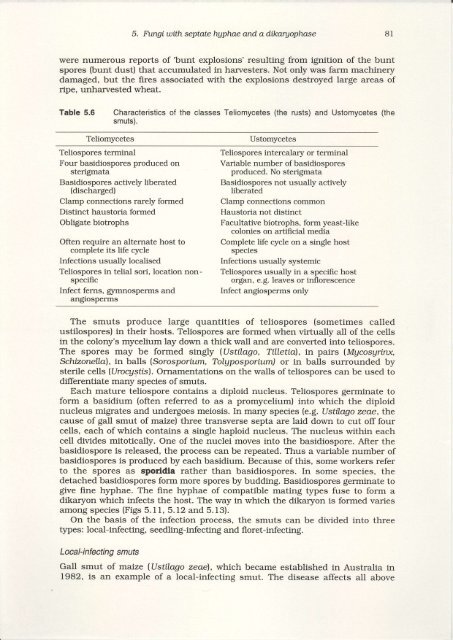Fungi with septate hyphae and a dikaryophase
Fungi with septate hyphae and a dikaryophase
Fungi with septate hyphae and a dikaryophase
You also want an ePaper? Increase the reach of your titles
YUMPU automatically turns print PDFs into web optimized ePapers that Google loves.
5. F\.ngi usith <strong>septate</strong> hgphae <strong>and</strong> a <strong>dikaryophase</strong><br />
were numerous reports of 'bunt explosions' resulting from ignition of the bunt<br />
spores (bunt dust) that accumulated in harvesters. Not only was farm machinery<br />
damaged, but the fires associated <strong>with</strong> the explosions destroyed large areas of<br />
ripe, unharvested wheat.<br />
Table 5.6 Characteristics of the classes Teliomycetes (the rusts) <strong>and</strong> Ustomycetes (the<br />
smuts).<br />
Teliomvcetes Ustomycetes<br />
Teliospores terminal<br />
Four basidiospores produced on<br />
sterigmata<br />
Basidiospores actively liberated<br />
(discharged)<br />
Clamp connections rarely formed<br />
Distinct haustoria formed<br />
Obligate biotrophs<br />
Often require an alternate host to<br />
complete its life cycle<br />
Infections usually localised<br />
Teliospores in telial sori, location nonspecific<br />
Infect ferns, grmnosperms <strong>and</strong><br />
angiosperms<br />
Teliospores intercalary or terminal<br />
Variable number of basidiospores<br />
produced. No sterigmata<br />
Basidiospores not usually actively<br />
liberated<br />
Clamp connections common<br />
Haustoria not distinct<br />
Facultative biotrophs, form yeast-like<br />
colonies on artificial media<br />
Complete life cycle on a single host<br />
species<br />
Infections usually systemic<br />
Teliospores usually in a specific host<br />
organ, e.g. leaves or inllorescence<br />
Infect angiosperms only<br />
The smuts produce large quantities of teliospores (sometimes called<br />
ustilospores) in their hosts. Teliospores are formed when virtually all of the cells<br />
in the colony's mycelium lay down a thick wall <strong>and</strong> are converted into teliospores.<br />
The spores may be formed singly (Ustil"ago, Tilletial, in pairs (Mgcosgrinx,<br />
SchizoneLta), in balls (Sorosporium, Totgposporium) or in balls surrounded by<br />
sterile cells (Urocysfrs). Ornamentations on the walls of teliospores can be used to<br />
differentiate m€ury species of smuts.<br />
Each mature teliospore contains a diploid nucleus. Teliospores germinate to<br />
form a basidium (often referred to as a promycelium) into which the diploid<br />
nucleus migrates <strong>and</strong> undergoes meiosis. In many species (e.9. Ustilago zeae, the<br />
cause of gall smut of maize) three transverse septa are laid down to cut off four<br />
cells, each of which contains a single haploid nucleus. The nucleus <strong>with</strong>in each<br />
cell divides mitotically. One of the nuclei moves into the basidiospore. After the<br />
basidiospore is released, the process can be repeated. Thus a variable number of<br />
basidiospores is produced by each basidium. Because of this, some workers refer<br />
to the spores as sporidia rather than basidiospores. In some species, the<br />
detached basidiospores form more spores by budding. Basidiospores germinate to<br />
give fine <strong>hyphae</strong>. The fine <strong>hyphae</strong> of compatible mating types fuse to form a<br />
dikaryon which infects the host. The way in which the dikaryon is formed varies<br />
among species (Figs 5.11, 5.12 <strong>and</strong> 5.f3).<br />
On the basis of the infection process, the smuts can be divided into three<br />
types : local-infecting, seedling-infecting <strong>and</strong> floret-infecting.<br />
Local-infecting smuts<br />
Gall smut of maize (UstiLago zeae), which became established in Australia in<br />
1982, is an example of a local-infecting smut. The disease affects all above<br />
81






![[Compatibility Mode].pdf](https://img.yumpu.com/27318716/1/190x135/compatibility-modepdf.jpg?quality=85)










